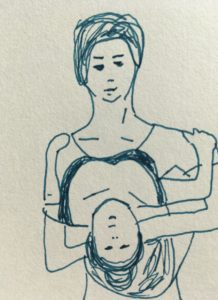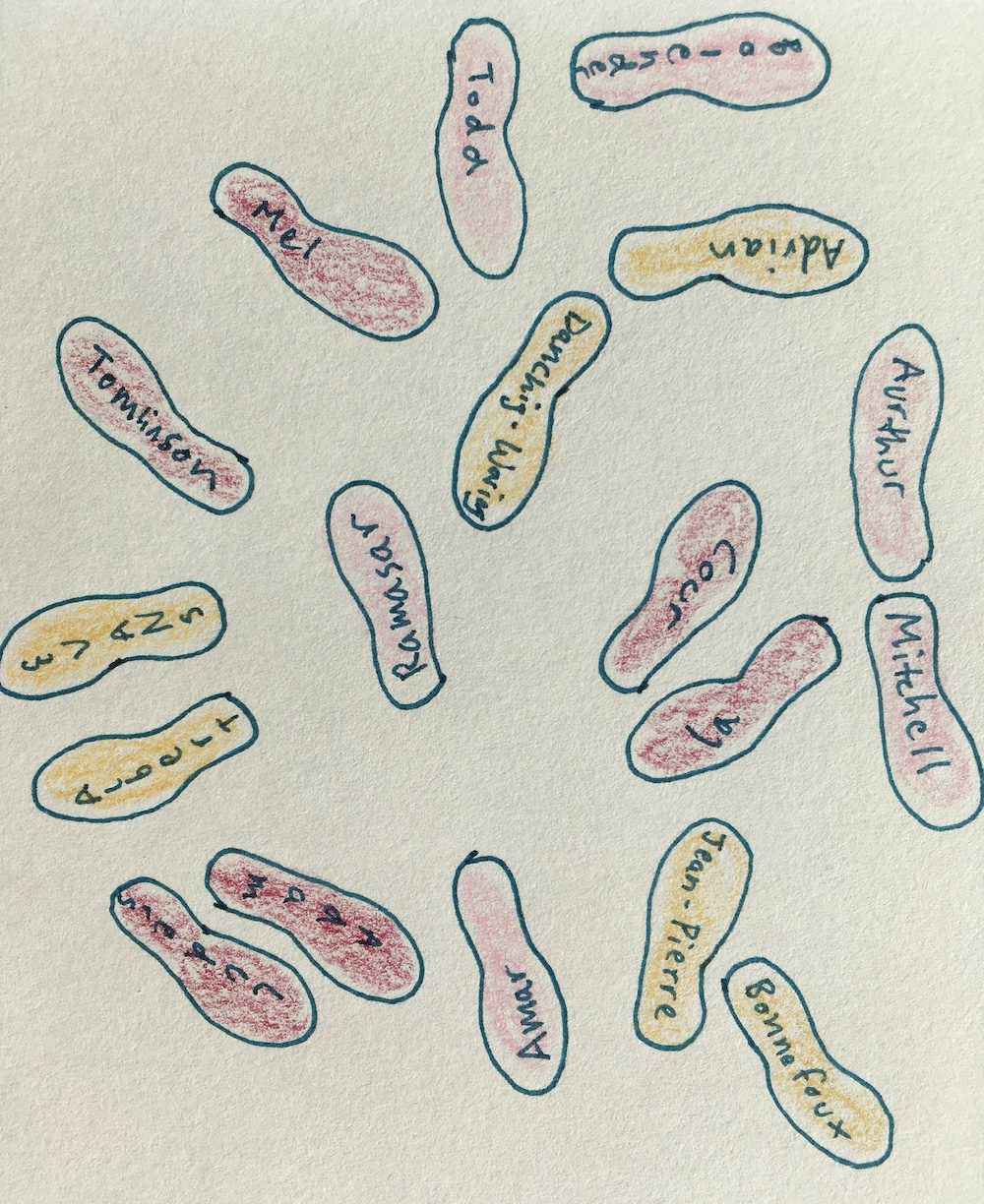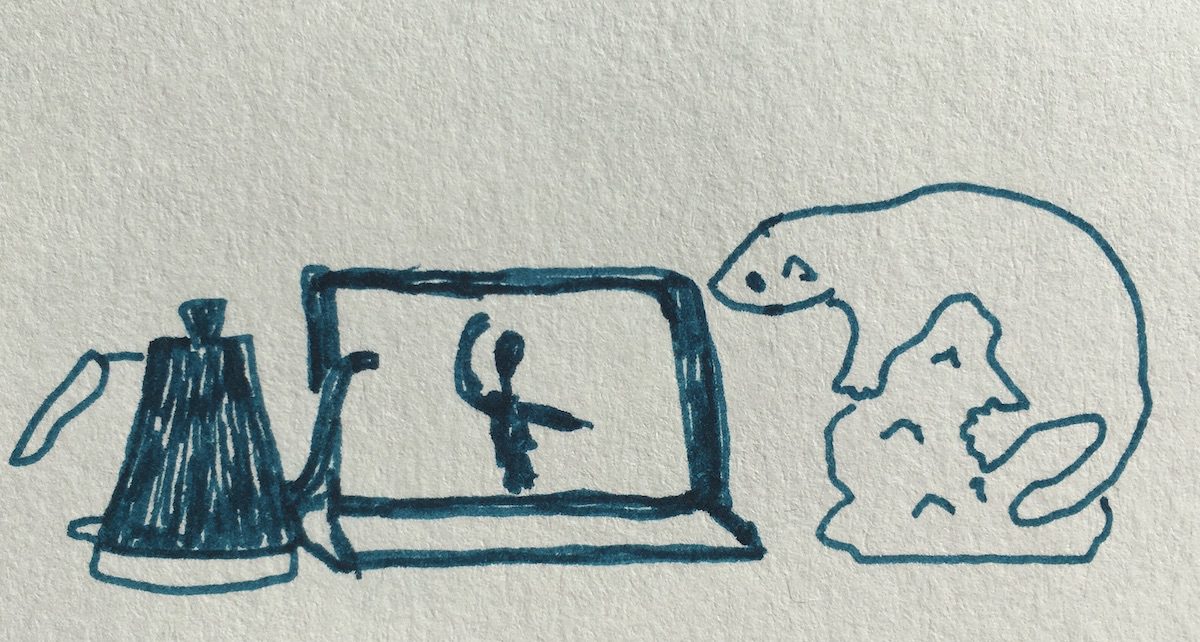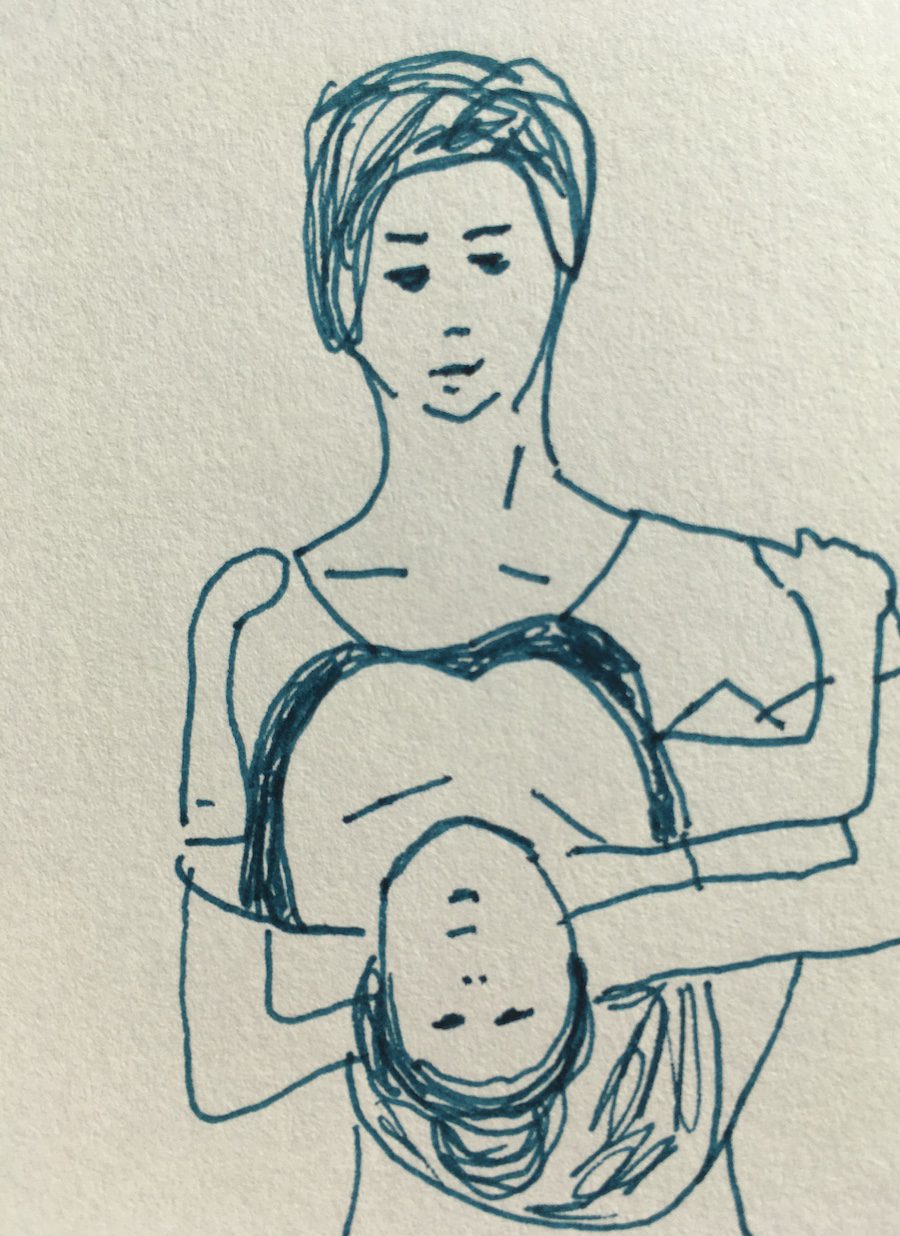
To dance is to dissolve the distinction between your actions and your being. Body parts blur and melt away. Feet, elbows, legs, and toes all become untethered and combine with the movement. Knowingly executing choreography is both medicine and magic.
To inhabit choreographed movements is to give yourself over to something greater. It’s a kind of freedom, but as you lose yourself, you lose your agency as well. In dancing, you become the repetition and the history of the steps.
When I dance The Four Temperaments, I am aware of the men who have danced my role before me. The ballet was choreographed in 1946 by George Balanchine; decades and decades of dancers live in this work. Some of them are my contemporaries at the New York City Ballet: Ask la Cour, Adrian Danchig-Waring, and Amar Ramasar. Before them, Albert Evans, Mel Tomlinson, Adam Luders, Jean-Pierre Bonnefoux, Arthur Mitchell, and Todd Bolender, among others, danced this role. I like to think I am a part of a shared lineage. I may not have these other dancers in mind while I’m on stage, but my movements and my interpretation of the steps are informed by these men and their dancing.
My role is in the Phlegmatic movement, the fourth section of the ballet. A little more than halfway through the work, when it’s my time to dance, I walk out of the wings alone and do an introspective solo that ends with me balancing on one leg, holding my foot in the air. After that, four women join me. We dance separately but near each other. Then we connect, winding around and through one another before settling into a line for an elegant prance. The first time I danced this role, I was tense from taking on such a historied ballet. I was nervous, up until the women joined me. Panting and sweaty from dancing alone, I grabbed their hands and squeezed, glad to be connected. The contact was grounding. The dance continued.
In my company, when one dancer gets sick it is a guarantee that at least five others will catch the same illness. We touch one another constantly, both out of choreographic necessity and out of the physical intimacy built up over years. We share decades of close proximity and the exhaustive experience that is dance. Ballet is demanding in both an energy-depleting way and a fully immersive, all-encompassing way, though maybe these are one and the same. It is communal and compulsive: being in a company means sharing the thing you love to do and can’t not do.
Most recently, dancers from the New York City Ballet “danced” the Phlegmatic section from The Four Temperaments in our living rooms or garages or kitchens; we were together, but separate. None of us remembered the steps particularly well and there were lots of choreographic inaccuracies. Craig Salstein, who gives company class six mornings a week via Zoom, sometimes picks a ballet for us to dance along to after class. On Wednesday, April 8, he picked the Phlegmatic section of The Four Temperaments. Twenty of us danced together, though the choreography calls for just five. A handful of us knew only some of the steps, but we all knew the music and could follow along, or at least appreciate the dance.
These days, dancing the way I’m used to is a hazard. I’ve accidentally stuck my finger up a partner’s nose on stage. I’ve dripped sweat into other dancers’ eyes and mouths. Spit and sweat fly when we dance, and our ballet barres—some made of wood, but mostly metal—are heavily trafficked. Each of us return to the barre multiple times a day. We grip this shared support system that we have been relying on since our very first moments of ballet.
Now, my barre each morning is the back of a green leather chair or sometimes the corner wall of my studio apartment where my living-dining space joins the area where I keep my bed. My fingers grasp the corner while I watch Craig give combinations on my iPad, which is wedged between my electric kettle and the taxidermied weasel my mom gave me for my birthday. Thirty-something of us from the company “gather” daily, each in our own apartments and homes, spread across the city, across the country, across the globe. Everyone peers at their phones or iPads or computers to look, wave, and learn the combination. Then, we dance.
After Zoom classes, I have no rehearsals. There is nothing to do. One of the ways I keep myself occupied during quarantine is writing about ballet. I write about my company. I write about dancers past and present. I write about the ballets I dance. (Danced.) I write about how it feels to dance, how it feels not to dance, why I dance, why I don’t always want to dance, and about watching dance. My writing circles around ideas of legacy and relevance, queerness, community, and tradition. Most recently, I’ve been writing about The Four Temperaments. I watch old clips, listen to the music, interview other dancers, read reviews and analyses, and take online quizzes to determine which temperament I am. (Melancholic.)
It’s a little heartbreaking to sit on FaceTime listening to people describe the experience of dancing instead of dancing, to be writing about dance instead of dancing, to be watching dance instead of dancing, but it’s also soothing and a reminder of what ballet does.
Balanchine wrote that The Four Temperaments:
…is an expression in dance and music of the ancient notion that the human organism is made up of four different humors, or temperaments. Each one of us possesses these four humors, but in different degrees, and it is from the dominance of one of them that the four physical and psychological types—melancholic, sanguinic, phlegmatic, and choleric—were derived… Although the score is based on this idea of the four temperaments, neither the music nor the ballet itself makes specific or literal interpretation of the idea. An understanding of the Greek and medieval notion of the temperaments was merely the point of departure for both the composer and the choreographer.
The idea of the four temperaments comes from the Hippocratic concept of humorism—the belief that a person’s mood, emotions, and health can be linked to an internal imbalance of the four fluids that comprise a body: phlegm, blood, yellow bile, and black bile. Too much black bile will make you melancholic, or gloomy and wistful, anxious. A melancholic person is perceptive and sensitive. They’re also moody. To be sanguine is to be bloody and connected to the air; social and enthusiastic, buoyant and confident. It sounds like a good thing, but a perceived excess of this red humor required bloodletting and leeching. Excessive phlegm in the body was thought to make you phlegmatic, unemotional and lethargic. The right amount of phlegm, though, was purifying; it lubricated and nourished the body. To be choleric is to have an excess of yellow bile. Yellow bile has to do with digestion and heat—processes that transform. The choleric humor stimulates and heats the body, opening up the airways. Too much of any humor was no good, and altogether they brought balance and harmony to the body.
The Four Temperaments, or 4Ts as the dancers call it, is about the body. It’s a ballet of excess and extremes that eventually come into balance—both in subject and in form.
The Four Temperaments was choreographed for Ballet Society, which was one of the precursors to the New York City Ballet. Ballet Society had commissioned the score from Paul Hindemith, and originally Balanchine intended to use the score for a ballet called The Cave of Sleep. He choreographed very little. The only solo, made for a dancer named Marjorie Moore, required the long ballerina to get down on the floor—not a typical ask for the time. Another dancer called Moore’s solo “torturous,” and it was scrapped before it reached the stage. When Balanchine returned to the music, the name of the piece was discarded, too, and what was to have been The Cave of Sleep became The Four Temperaments, named after the Hindemith score: “Theme with Four Variations (According to the Four Temperaments).”
When it premiered, the ballet had a wholly different ending, as well as elaborate costumes designed by Kurt Seligmann. The costumes were suede and wool and hid the dancers’ bodies. Yet even with the excessive fabrics, when The Four Temperaments first premiered, the extreme movements and skewed classicism revealed bodies in new ways. This aesthetic became more intense in 1951 when Balanchine got rid of Seligmann’s costumes for the “practice clothes look”: simple costuming that he felt would not distract from his dances. The choreography changed in subsequent years, too, and the ballet is now known in part for its starkness.
There’s a version on YouTube that was filmed on soundstage in Nashville in 1977 that’s near perfect. (For the record, it is not the final version of the steps as set by Balanchine.) At first look, the harsh simplicity of the dancers’ uniforms makes the image. Their bodies only reveal themselves in movement. “He” is in a tight white t-shirt that is really a leotard, black tights, and white socks with white shoes. “She” is in a black thin-strapped leotard and thick black belt. When everyone is on stage together at the end, they almost look the same—but look again. You can see her protruding hips, his ribbon arms, their unusual proportions, her skeleton, and the smoothed-over lumps and swerves of his body. Their faces are masks of stoicism. Still, their humanity is everywhere.
The ballet progresses as a series of distinct dances, connected thematically by the music and the choreography. Three different couples dance the three themes that open the ballet, setting the tone and the vocabulary for what is to come: classical ballet elongated and distorted into exaggerated shapes and dynamics. When the three duets end, the next four movements each take the names of a temperament: Melancholic, Sanguinic, Phlegmatic, and Choleric. Melancholic, a dance of push and pull and jutting hips, is for one bendy man and six severe women. Sanguinic is danced by an energetic couple who sail serenely through their athletic combinations while four women called “the roaches” dance around them, fluttering their arms and practically jamming their toes into the floor. Phlegmatic is for five long dancers, one man and four women, who prance and sweep their limbs in a detached, incidental seduction. Choleric is danced by one woman who flies across the stage, legs and arms going every which way in a display of raw power.
It isn’t until that final movement that the temperaments and themes all mix. At the end, every dancer who has already danced is on stage together. In the last moments of the ballet, two rows of dancers do a kick line with zombie-stiff arms, followed by a dance of changing, rhythmic poses. Four couples cross past and behind the lines, shooting up into explosive lifts right before the curtain comes down on the two rows of dancers in a lunge, pushing toward the wings.
When I was taught the final steps of this ballet by NYCB ballet mistress Rosemary Dunleavy she said, “There! You just learned a masterpiece.”
I could have cried.
To learn more about 4Ts, I watched a video on YouTube of dance writer Robert Greskovic interviewing Todd Bolender. Bolender was the original male dancer in the Phlegmatic section when the work premiered.
In this 1997 interview with Greskovic, Bolender reminisced about what it was like to dance for Balanchine at this time as part of the early days of the New York City Ballet’s history, before it was even the New York City Ballet.
When Greskovic asked if any other dancer ever replaced him in Phlegmatic while he was dancing for Balanchine, Bolender said no, but that one night it almost had to happen.
He said, “I was terribly ill with bronchitis… I had a high fever and everything.”
But because no one else knew the part, he still agreed to go into the theater:
So they got me all dressed and wrapped up and so forth. I could barely get in. I was a wreck. So Balanchine is there, and he took my temperature. It was a 102 temperature. He said, “Oh my God, that’s a lot.” So he said, “Well, I don’t know, do you think you could dance it?” I said, “No, but I’ll try.” He said, “Well, do. It would be wonderful if you did.”
And then Todd Bolender went out and danced Phlegmatic with bronchitis and a 102 degree fever. And he went on to live to ninety-two, may we all be so lucky.
I have colleagues who have danced with walking pneumonia, strep, shingles, broken bones, and torn ligaments. Colleagues have danced through divorce, a child’s sickness, a parent’s death, and through dealing with their apartment burning down. It is a badge of honor, a sign of your strength and worth, if you can push through calamity and still make it onto the stage.
After class one day, I talked to Deborah Wingert on FaceTime about 4Ts. She was in the company for thirteen years, starting in 1982, and has remained a part of Balanchine’s world, teaching his ballets and training students to prepare them for his works. She danced Phlegmatic for almost her entire tenure in the company. Our conversation about 4Ts brought us to larger conversations about dance, technique, commitment, and repetition.
She said, “I think coming to class, being there together, was super important… We come to class to do the work. And it’s hard work. And we come there to do that because it makes us better, because then the work is better.”
Ballet joins us as a community. It’s a discipline that goes beyond our six-days-a-week class. It’s the coming together. It’s the group effort, giving the sense that everyone and everything is essential.
Being in my apartment with no space to dance and no one to dance with, I think a lot about the utility of ballet. This isn’t new for me. I question ballet when confronted with the problematic aspects of its legacy. I am embarrassed when I find myself obsessing about the fit of my costume or the line of my leg, aware that my world as a dancer can tend towards myopic self-focus. And when my back is in spasm, I wonder if dancing is really all that worth it.
Why do I dance? Why have I invested so much of my life in ballet? While sheltering in place as a non-essential worker—a privilege I am grateful for—I have been able to think about these questions and find some answers that satisfy me. Ballet for me has been about intimacy-building, and it has given me a community. It gives me a sense of purpose and connects me to the other dancers on stage, to the many other dancers who have danced this work before me, to the music, to the audience, to a community built on a mutual appreciation and pursuit of something beautiful. Part of its significance is its history and part of it is that it’s nice to do a fun dance to good music with people you like. I miss the specific pleasure of dancing with others. Zoom does something, but it can’t replace being in a theater or a studio with living, breathing, sweating, moving dancers right there alongside you. There’s no eye contact, no touch, no damp embraces.
During class now, Craig sometimes plays New York City Ballet music. We dance to piano reductions of Serenade, A Midsummer Night’s Dream, Western Symphony.
“This one’s for Maria Kowroski,” Craig says, before we do ronds de jambe to the second movement of Symphony in C. In my apartment I can’t do double tours; I’m afraid to do pirouettes even, afraid to do much of anything for fear I’ll slip and hurt myself, but I am moving to this music with my company and that is something. We do tendues to music from the scherzo in Diamonds and while dancing in my apartment in my socks and pajamas, I picture the sparkle of our costumes and the rush of bodies around me.
The 1977 recording of The Four Temperaments aired as part of the Dance in America series on PBS, and I watched it on VHS when I was a teenager. On YouTube, the recording is fuzzy and slightly distorted from the upload, but it’s still good. By the time this was filmed, the ballet was already an iconic work. Iconic Balanchine. Iconic New York City Ballet. Iconic ballet. The dancers and their dancing in this broadcast are emblematic of how this ballet should be danced. Maybe this version stands out for me because it was the first one I saw, but even when I watch it now, I see the intention of the piece with a rare kind of clarity. The ballet is almost dry in its presentation: not stale or stiff, but matter-of-fact and pristine. There is no excess. It’s all just right.
Arlene Croce wrote beautifully about the final movement of The Four Temperaments:
Choleric enters in a burst of fanfares and flourishes, kicking the air. Her fury must be appeased, assimilated by the ballet’s bloodstream. The entire cast collaborates in the process. Key motifs are recapitulated in tempi that charge them with new vitality. We are racing toward the finality of a decision, and then it comes. Those ronds de jambe are a space and air-clearing gesture. Three circles traced on the ground: it is the most wonderful of the ballet’s magic signs; the vastness of it incorporates all bodies into one body, all worlds into one planet. After a silence in which nobody moves, the great fudge of the finale begins its inexorable massed attack. All the parts the ballet is made of are now seen at once in a spectacle of grand-scale assimilation. Apotheosis. We see a succession of sky-sweeping lifts; we see a runway lined by a chorus of grand battements turned to the four points of the compass. The lifts travel down the runway and out as the curtain falls.
The ending of 4Ts is a whole, uniting. A body, balanced. People once separate are now joined. Its positivity is assertive and straightforward. Watching the ballet balances my humors, bringing out the elements that comprise my separate, solitary body. I am sad, thinking of my colleagues and of dancing with space. At the same time, I am engaged: euphoric and energized by the dance. I feel like a blob, in my hoodie and pajama pants, languid, just writing about myself, about ballet. To what end? I feel angry and irritated watching a performance none of us can do right now, jealous of the dancers touching one another.
As I watch this final sequence again on YouTube, a cry and a cheer goes up outside and all around New York City. Pots and pans bang. Whistles blow. There are big whoops and applause for all of those still working, allowing the rest of us to stay inside, separate and healthy.
Ballet does not provide immunity or life support or safety, nor does it help you breathe easier—but it can offer hope and a vision of something wonderful, something enduring, something to look forward to, something to escape into. Ballet connects us to an untroubled, unruffled humanity.
In the recording, the dancers gather close for the finale. With the swells of the music, they generate a force and a momentum that isn’t contained by the steps. The dance soars. The music ascends hopefully. There are high flying, exciting take-offs and the dancers are all there, dancing together.
***
Rumpus original art by Elizabeth Schmuhl.








